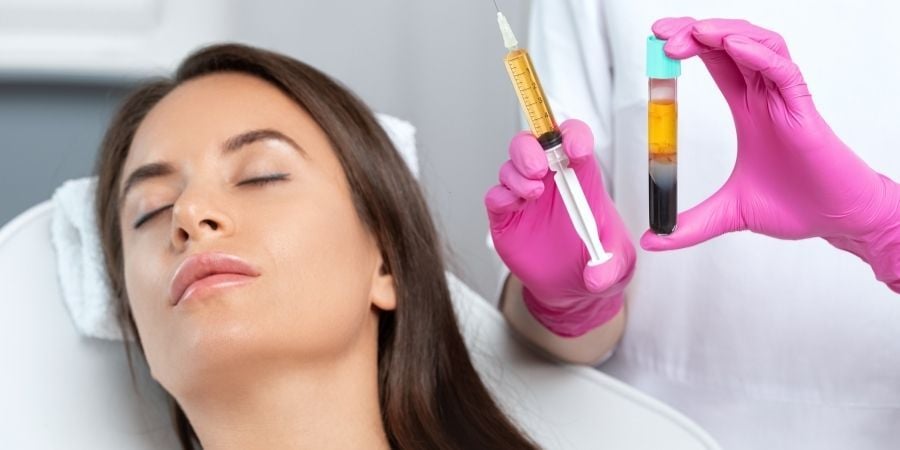Posted By:
The Hampton Clinic
Share:
%20(1).jpg)
Hair loss, especially in women, is not very often spoken about, as if it’s something we should hide or simply accept; yet for so many people, it has a profound impact that goes so far beyond just appearance. The way we wear our hair is tied to our identity, to how we perceive ourselves and want to be perceived. When hair begins to thin or recede, it can seriously affect our self confidence and self- image.
At The Hampton Clinic, we see many clients who come to consultations because they’re tired after trying everything - shampoos, supplements, topical solutions and serums that promise dramatic regrowth. Most feel frustrated by the lack of results and don’t know what to do next. So we’re here to talk about how regenerative treatments, specifically PRF and PRP, can help you on your hair loss journey.
Before talking about treatments, we want to explain what’s happening biologically. Hair growth follows a cycle: growth (anagen), transition (catagen), resting (telogen), and shedding (exogen). At any given time, most of our hair is in the growth phase. But genetics, hormones, stress, nutritional deficiencies and ageing can change this balance, leaving more follicles in the resting or shedding phases.
For women, the menopausal transition is particularly difficult. As oestrogen and progesterone levels decline, hair often becomes sparser and more fragile. This is different to male-pattern hair loss, where testosterone converts into DHT, shrinking hair follicles over time. In both men and women, the result is the same: reduced density, thinner hair and slower regrowth.
Many over-the-counter treatments focus only on the surface, giving the illusion of thicker hair or stimulating the scalp without addressing the follicle environment. Cosmetic solutions like shampoos and serums may make the hair feel better but are not capable of changing its long-term growth behaviour.
This is why so many people feel like they’ve “tried everything.” The truth is, if the root cause isn’t being targeted, visible results are unlikely.
PRF (Platelet-Rich Fibrin) and PRP (Platelet-Rich Plasma) take a different approach. Instead of introducing something foreign to the body, these treatments use your own blood components to stimulate repair and regeneration.
Here’s how it works: a small blood sample is taken and processed in a centrifuge to separate out the platelets and growth factors. These are the parts of your blood responsible for healing wounds, repairing tissue and encouraging cell turnover. When reintroduced into the scalp, they release signals that wake up dormant follicles, improve blood supply, and create the right environment for hair growth to restart.
PRF is the next generation of PRP. It uses a slower spin process and contains not only platelets, but also white blood cells and stem cell-like components that extend the release of growth factors over time. This means the scalp benefits for longer, making it especially effective for stubborn or advanced thinning.
For women experiencing menopausal hair loss, PRF/PRP is particularly effective because it works in harmony with the body, supporting the follicle with the very growth signals it needs.
We’ve seen clients who thought they had no options left experience visible improvements in hair density after a course of treatments. While results vary, the outcomes can be genuinely life-changing - but patience is important since hair growth is a slow biological process.
It’s important to remember that hair loss affects men and women differently, but both can benefit from regenerative treatments. Men with early signs of baldness often respond particularly well, as follicles are still active, while women struggling with diffuse thinning across the scalp will regain density and strength.
The process is straightforward. After a consultation to assess suitability, a course of treatments is planned, usually spaced a few weeks apart. Because the treatment uses your own blood, the risk of reaction is extremely rare. Side effects are generally mild, such as some tenderness or swelling in the treated area that resolves within a day or two.
Results develop gradually. Most patients start noticing changes within the first couple of months, as new hair grows in and existing strands become thicker and healthier. The emotional shift is just as meaningful as the physical change, seeing progress where once there was only decline.
PRF and PRP for hair loss are part of a wider movement in aesthetics: regenerative medicine. Instead of relying on artificial fixes, these treatments work with the body to repair and reset. For hair, this means treating the scalp as the living environment it is.
For those living with hair loss - caused by genetics, hormones, ageing or stress - knowing that there’s an option rooted in science, with safety and natural biology at its core, can be transformative.
%20(1).jpg)
Sep 12, 2025 5:15:00 PM
-1.jpg)
Sep 4, 2025 3:15:00 PM

Aug 27, 2025 12:30:00 PM

Aug 20, 2025 1:30:00 PM

Copyright @ 2025 The Hampton Clinic